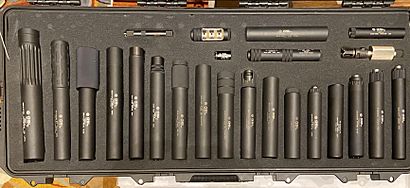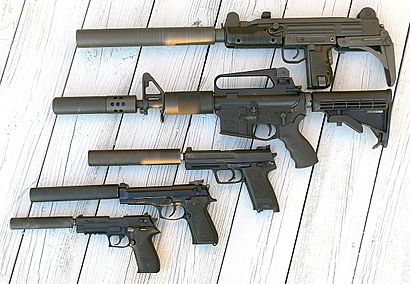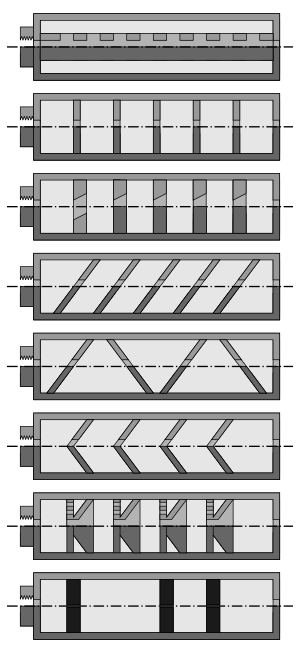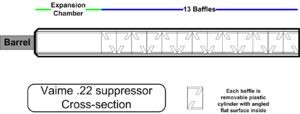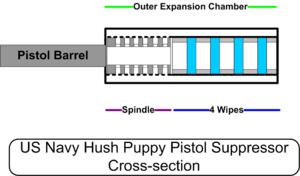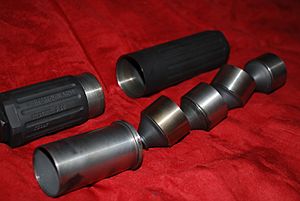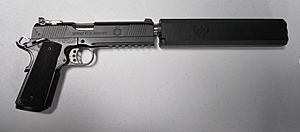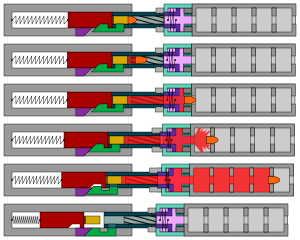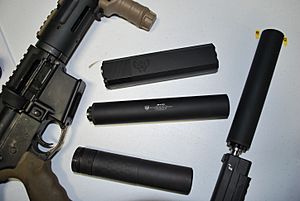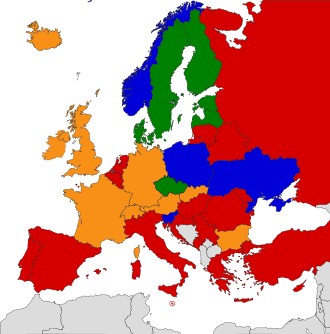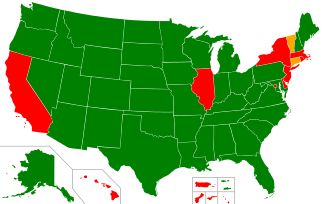Silencer (firearms) facts for kids
A silencer, also called a sound suppressor or sound moderator, is a special device attached to the end of a gun barrel. Its main job is to make the loud bang of a gun much quieter when it's fired. It does this by controlling the fast-moving gases that rush out of the barrel.
Imagine a balloon popping – that's a loud sound because the air rushes out all at once. A silencer works a bit like letting the air out of a balloon slowly. When a gun is fired, hot, high-pressure gases push the bullet out. A silencer has many small rooms, called baffles, inside it. These baffles make the gases take a longer, winding path. This slows down the gases and cools them, spreading out the loud blast over a longer time. This makes the gunshot sound much softer.
Silencers can also help reduce the gun's "kick" (recoil) and the bright flash that comes out of the barrel when fired. This is different from a flash hider, which only hides the flash, or a muzzle brake, which mainly reduces recoil by sending gases sideways.
Contents
History of Silencers
The idea of making guns quieter isn't new! A Swiss inventor named Jakob Stahel patented a silencer in 1892.
However, the person usually given credit for inventing and selling the first successful silencer was an American named Hiram Percy Maxim. He was the son of the inventor of the famous Maxim gun. Around 1902, he created his "Maxim Silencer" and got a patent for it in 1909. He advertised it in sports magazines. Interestingly, the "muffler" used in cars to make engines quieter was developed around the same time by Maxim, using many of the same ideas!
Even former U.S. President Theodore Roosevelt was known to buy and use Maxim Silencers.
During World War II, special agents used silencers. For example, agents from the U.S. Office of Strategic Services (OSS) used a special .22 pistol with a silencer. The head of the OSS even showed one to President Franklin D. Roosevelt at the White House!
More recently, in 2020, the United States Marine Corps started giving silencers to their combat units. They found that it helped soldiers talk to each other better because the loud noise was reduced. They plan to have many more by 2023.
What Are They Called?
You might hear these devices called "silencers" or "suppressors." "Silencer" is the older, more traditional name. Hiram Percy Maxim, the inventor, called his invention the "Maxim Silencer."
However, in recent years, especially in the United States, the term "suppressor" has become more common. Groups like the American Suppressor Association (ASA) prefer this term. They say that "silencer" makes people think the gun becomes completely silent, like in movies, which isn't true. A gun with a silencer is still loud, but much quieter than without one. "Suppressor" suggests that it only reduces the sound, which is more accurate.
Both terms are used, and dictionaries often say they mean the same thing.
How Gun Noise Is Made
When a gun fires, the sound comes from three main things:
- Muzzle blast: This is the loudest part. It's the sound of hot, high-pressure gases bursting out of the barrel after the bullet leaves.
- Sonic boom: If the bullet travels faster than the speed of sound (which many do), it creates a small "crack" sound, like a tiny sonic boom.
- Mechanical noise: This is the sound of the gun's moving parts as it fires and gets ready for the next shot.
A silencer can only reduce the noise from the muzzle blast. It can't stop the sonic boom if the bullet is super fast, and it can't stop the mechanical sounds of the gun working.
Because of this, it's very hard to make a gun completely silent. Also, some types of guns, like revolvers, are harder to make quiet because gases can escape from small gaps between the barrel and other parts.
How Silencers Are Designed
Most silencers are hollow metal tubes, usually made from strong metals like steel, aluminum, or titanium. They attach to the end of a gun barrel. Some silencers are "detachable," meaning you can take them off and put them on different guns. Others are "integral," meaning they are built right into the gun's barrel.
Both types work by letting the hot gases from the gun expand and cool down in a series of small rooms or chambers inside the silencer. These chambers are separated by metal dividers called baffles.
Baffles and Spacers
Baffles are like small metal plates inside the silencer, each with a hole in the middle for the bullet to pass through. They are designed to make the gases swirl around and lose energy, which reduces the sound. The hole for the bullet is usually a tiny bit bigger than the bullet itself to make sure the bullet doesn't hit the baffle.
Baffles are often made from tough metals that can handle the heat and pressure. Some modern silencers have baffles shaped in special ways to direct the gases even better.
Over time, the hot gases can wear down the baffles, especially with a lot of shooting. High-quality silencers are built to last for many thousands of shots.
Spacers are used to keep the baffles in place and at the right distance from each other inside the silencer. Sometimes, the baffles and spacers are made as one piece.
Wet Silencers
Some silencers, called "wet silencers," use a small amount of water, oil, or gel inside the chambers. This liquid helps cool the gases even more, which makes the silencer work better for a few shots. Water is very good at this because it absorbs a lot of heat. However, the liquid needs to be refilled after a few shots. Most modern silencers don't use liquids because they can be messy and require more cleaning.
How They Attach
Most silencers screw onto the end of a gun barrel. For very powerful rifles, some silencers use a "quick-detach" system. This allows a shooter to quickly add or remove the silencer, often over an existing part like a flash hider, and it has a special lock to keep it secure.
What Silencers Do (Besides Quieting)
Besides making a gun quieter, silencers have other benefits:
- Less Recoil: They help reduce the gun's kickback. This is because they slow down the gases that contribute to the recoil. The added weight of the silencer at the end of the barrel also helps make the gun feel more stable.
- Less Muzzle Flash: The bright flash of light that comes from the barrel is greatly reduced or even eliminated. This is because the silencer traps and cools the burning gases.
- Hearing Protection: For the shooter and anyone nearby, silencers offer important hearing protection. Gunshots are incredibly loud and can cause permanent hearing damage very quickly. While a silencer doesn't make a gun completely silent, it makes it much safer for your ears.
- Better Shooting: With less noise, recoil, and flash, shooters can concentrate better and often shoot more accurately, especially if they need to fire multiple shots.
- Less Lead Vapor: Silencers can also help trap some of the lead vapor that comes out of the barrel, which means less of it is breathed in by the shooter.
Subsonic Ammunition
Remember how we talked about the "sonic boom" a bullet makes if it travels faster than the speed of sound? To get rid of this sound, shooters can use subsonic ammunition. These bullets are designed to travel slower than the speed of sound.
The downside is that subsonic bullets have less energy and a shorter range. To make up for this, they often use heavier bullets. For example, a special cartridge called the ".300 Whisper" uses a heavy bullet that stays subsonic but still delivers good power.
Many common pistol calibers, like the 9mm, have heavier bullets that are naturally subsonic, making them good choices for suppressed shooting.
Some silencers, called "integrals," are designed to slow down even regular supersonic ammunition by letting some gas escape along the barrel before the bullet leaves.
How Effective Are They?
Even a small .22 handgun without a silencer can make a sound louder than 160 decibels (dB). For comparison, a rock concert is around 100-120 dB, and a jet engine is about 140 dB. Sounds above 140 dB can instantly damage your hearing.
Silencers can reduce the sound of a gunshot by 17 to 32 dB. This is a big difference! While a suppressed gunshot is still loud (often above 130 dB), it's much safer for your ears than an unsuppressed one. Many people still choose to wear extra ear protection even when using a silencer, especially with powerful guns.
The U.S. Marine Corps decided to use silencers partly because hearing damage is a big problem for former soldiers. Using silencers can help protect their hearing.
Rules and Laws
The rules about owning and using silencers are very different around the world.
- In some countries, like Finland, France, and New Zealand, it's quite easy to buy silencers, sometimes even without a special permit.
- In other places, like Germany, if you have a hunting license, you can buy a silencer for your hunting rifle.
- In the United Kingdom, you need a special permission on your firearm certificate to buy a "sound moderator."
In North America:
- In Canada, silencers are generally "prohibited devices," meaning they are very difficult for regular people to own.
- In the United States, silencers are legal for individuals to own in most states (42 out of 50). However, buying one involves a special application process with the government, a background check, and a $200 tax. Some states, like California and New York, do not allow civilians to own silencers at all.
Images for kids


